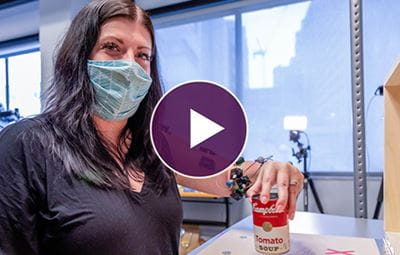 |
Spinal stimulation revives a woman's arm.
|
A neurotechnology that stimulates the spinal cord instantly improves arm and hand mobility, enabling people affected by moderate to severe stroke to conduct their normal daily activities more easily, report researchers from the University of Pittsburgh and Carnegie Mellon University today in Nature Medicine ⧉.
A pair of thin metal electrodes resembling strands of spaghetti implanted along the neck engage intact neural circuits, allowing stroke patients to fully open and close their fist, lift their arm above their head or use a fork and knife to cut a piece of steak for the first time in years.
We discovered that electrical stimulation of specific spinal cord regions enables patients to move their arm in ways that they are not able to do without the stimulation. Perhaps even more interesting, we found that after a few weeks of use, some of these improvements endure when the stimulation is switched off, indicating exciting avenues for the future of stroke therapies. Thanks to years of preclinical research building up to this point, we have developed a practical, easy-to-use stimulation protocol adapting existing FDA-approved clinical technologies that could be easily translated to the hospital and quickly moved from the lab to the clinic.corresponding and co-senior author Marco Capogrosso, Ph.D., assistant professor of neurological surgery at Pitt.
In a series of tests adapted to individual patients, stimulation enabled participants to perform tasks of different complexity, from moving a hollow metal cylinder to grasping common household objects, such as a can of soup, and opening a lock. Clinical assessments showed that stimulation targeting cervical nerve roots immediately improves strength, range of movement and function of the arm and hand.
Unexpectedly, the effects of stimulation seem to be longer-lasting than scientists originally thought and persisted even after the device was removed, suggesting it could be used both as an assistive and a restorative method for upper limb recovery. Indeed, the immediate effects of the stimulation enable administration of intense physical training that, in turn, could lead to even stronger long-term improvements in the absence of the stimulation.
Moving forward, researchers continue to enroll additional trial participants to understand which stroke patients can benefit most from this therapy and how to optimize stimulation protocols for different severity levels.








